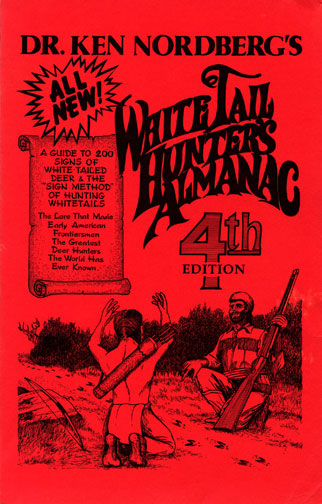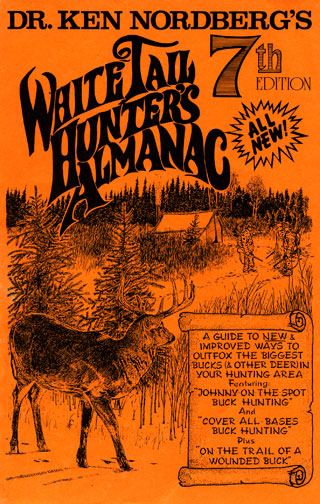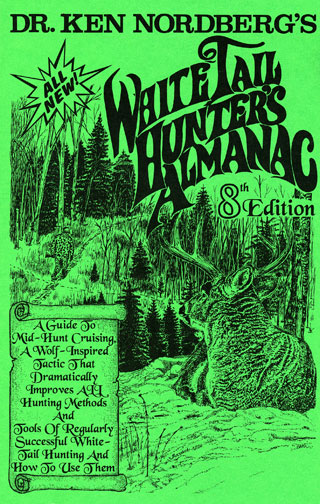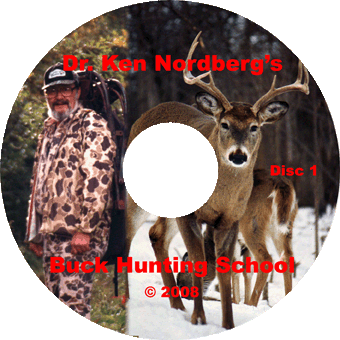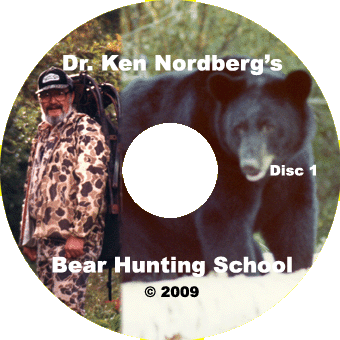A Lesson In Mobility — The Seven-Stand Buck
By Dr. Ken Nordberg
The following is the another of many older articles that will appear on my website. This is article was first published in Midwest Outdoors in December of 1996. Please share what you learn from these articles with your whitetail hunting friends.
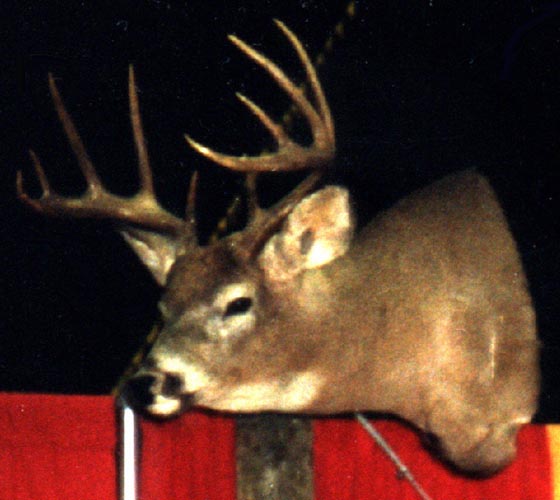
Dr. Ken Nordberg's biggest buck, a 10-pointer. (about 1975)
Author's Note: If your past hunting season did not end as you dreamt it would, chances are predictability (yours) had a lot to do with it. The adult deer you hunt probably find it relatively easy to predict where you will walk and sit while hunting, and when, making it easy for them to avoid you. Back in 1990 when I wrote the following account of a hunt, I was just beginning to understand the value of using multiple stand sites during the course of a hunting season, thereby eliminating much of such predictability. Upon adopting the use of a portable stool in 1992 (ground level stand hunting, introduced in Whitetail Hunter's Almanac, 5th Edition), I was finally able to completely eliminate this handicap, making it impossible for any deer (buck) to endlessly avoid me. Though using the tree stand hunting approach, the following account of an actual hunt will give you something important to think about. Between now and next season, make it a point to eliminate predictability in your hunting. [Here is a link to a related story Doc wrote in 2003, “Unpredictability — The Final Key to Hunting Success.”]
The following is a true account of an unusual hunt. I am relating this tale because it represents the ultimate in mobile stand hunting, I think, demonstrating how far mobile stand hunting can be carried, and how effective it can be even when the quarry is extraordinarily cunning. I realize, of course, few hunters have the opportunity to enjoy as much time afield as I during hunting seasons, and thus few would know a “seven-stand buck.” It's a tale that offers a special promise, however, to every hunter. That promise is this: given the time, this is a method of hunting that will make you the match of any white-tailed buck.
The buck wasn't difficult to keep track of. He was the only whitetail in my hunting area with tracks measuring six inches from tip to dewclaw and the only one with a large tip missing from its right front hoof. I hardly needed to dig out my steel tape upon spotting his track.
The first time I saw him, he looked exactly like I thought he'd look — a big 5-1/2 year-old weighing over 300 pounds with a magnificent 10-point rack. That was on opening morning at a stand site I had worked hard on.
It took two days of thorough scouting to find his bedroom. I was surprised to find it so near our traditional camp site. I knew the buck was in the area, but I didn't bother, at first, searching for a dominant buck bedroom in that area, figuring a smart, old buck would never bed so near a road. [Editorial Note: “Buck Bedroom” is just one term Doc introduced and made commonplace in deer hunting terminology.] I was taking a shortcut back toward camp in the rain when I ran into his single velvet rub. Seeing his big tracks and 3/4-inch droppings on the faint trail next to this rub, I knew at once I finally found it (his bedroom). This would be my Phase IV stand site, one I used as soon as the primary breeding phase of the rut was over. I figured that would happen by the second weekend of the firearm hunting season. [Editorial Note: “Phase IV” refers to the stage of the rut. If you are familiar with the five stages of the rut, it is because of Doc’s biological research on whitetail bucks. If you are not familiar with the stages of the rut, it is an essential bit of knowledge required to understand trophy-class bucks.]
That year, I had a brand new climbing tree stand I was anxious to try out. That was my first mistake. The buck's bedroom was located in an area thick with second-growth popples, clearcut six years earlier. There was only one tree in the vicinity that could support my climber — a mature maple with heavy branches only nine feet from the ground. This meant I could only climb nine feet at this site and I would have very little screening cover at stand level.
As I carefully followed my trail leading to my maple tree in the pre-dawn darkness opening morning, I was rightfully excited. I figured at that moment the buck was with a doe in estrus about 1/4-mile northeast of my stand, trailing the doe and her fawn as they browsed in a favored stand of mountain maples. Judging by their tracks, I figured they would return to the doe's bedding area 1/4-mile south via the only good trail leading in that direction through the second-growth popples — the one I had brushed-out by hand three weeks earlier. After camp was set up during the previous evening, I had hiked west along the logging road to see what I might see. The buck had crossed north and then south again trailing the doe and fawn that morning, and they had used the trail leading past my buck bedroom stand.
The sky was barely light when I heard a vehicle slowly cruise past my camp. South of the feeding area, it suddenly stopped. Then I heard someone curse, a car door slam and then the vehicle continued west. I figured someone had spotted the three deer crossing the logging road. As I sat there hoping the buck's pattern of movements hadn't been upset, there was a sudden movement only 50 yards away. Stifling the urge to grab my rifle, I froze, waiting to see what would happen next. Then there it was. The big buck was standing behind a clump of alders on the left side of the trail only 30 yards before me. The only trouble was, it was staring straight at me. I couldn't move. Then it's tail went up and it turned into the thick popples. I caught a couple of glimpses of it as it moved intermittently south.
Suddenly brush snapped further up the trail. This time I was ready, my rifle at my shoulder. Two deer were coming my way. At the spot where the buck had halted, they suddenly stopped, and their trails also rose. Peering anxiously about the area, they seemed confused. They were smelling the buck's danger scent, but they didn't know where the danger was. The doe decided to move out quickly, passing near my stand through the thick popples on my left. Shortly, the fawn followed. Neither of these deer had detected me in the maple tree as they passed. I could easily have harvested either one.
Two days of patient sitting at that same stand site proved fruitless. None of the three deer used the trail past the maple tree after opening morning. I had plenty of time, however, to think about what had gone wrong. The buck had spotted me, and though I hadn't moved, it didn't trust the strange new mass that had suddenly appeared in the maple next to this familiar trail. In typical adult buck fashion, it didn't take any chances. Especially after getting a good look at that buck, however, I was more determined than ever to ignore all other deer. As I headed for camp on Sunday evening, I kicked myself, saying, “I should've sat backwards in my stand on the other side of the maple, using it and those heavier branches as a blind. Well, buck,” I added, “I'll get you yet. I outfoxed you once; I'll do it again.”

Doc demonstrating the use of the climber he refers to in the story. With this model, normally, you face the tree while climbing, and face away from the tree in the reclining sling style seat when hunting.
Another hike that evening revealed the buck had not crossed into the northern half of its 1000-acre breeding range. The doe I saw it with on the opener could no longer be in estrus. That meant the buck was probably with the doe whose home range was southeast of camp. I had several permanent stands in that range. [Editorial Note: Back then, us Nordbergs used many “permanent” tree stands — after all commercial designs were only just coming out.]
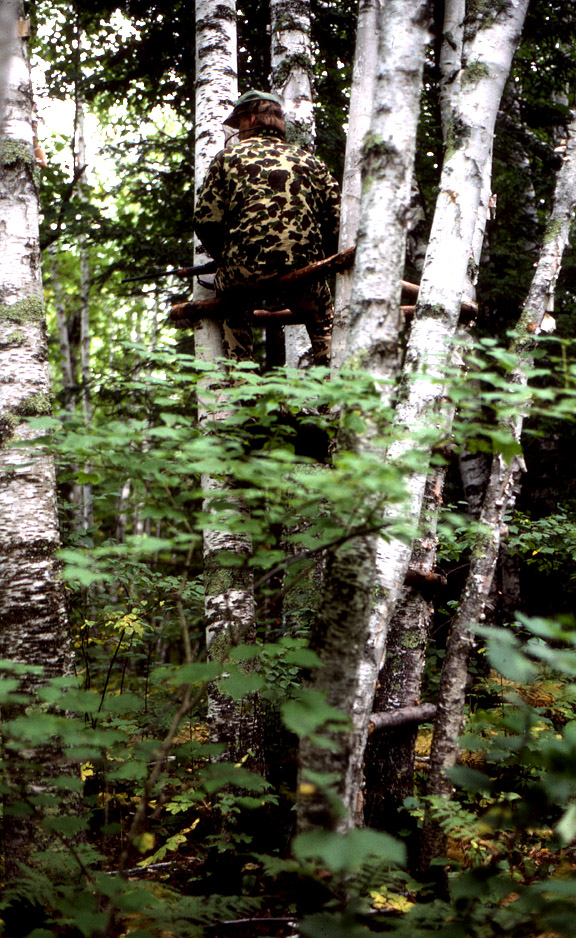
This is just one of many permanent treestands we had in that area at that time.
Well before first light the following morning, headed to a stand overlooking the perimeter of a favorite staging area of the deer in the southeast, a lowland thick with aspens, balsams and cedars. Whitetails regularly gather here before and after feeding in the small, new clearcut directly east. A good fifteen minutes before legal shooting time, two deer crashed through the hazels and evergreens 50 yards south of my stand. It happened so fast that I didn't have a chance to identify them. A few minutes later, a deer crossed back over the trail angling straight south. Its big rack was unmistakable against the snowy background, but it was still too early to shoot. Then a fawn crossed in the buck's path.
Ten minutes later, the same two deer bolted noisily across this opening again, the big dominant buck charging after the fleeing fawn. Figuring the fawn's mother was hidden in the thick hazels on my right, I was certain the dominant buck would soon return. This time I was ready. “Stick your nose into that trail again,” I silently murmured, “and you're history ol' buck.” But I didn't see him again. As I learned later, the doe had moved south and the buck had rejoined her out of sight and out of range. Upon spotting the doe and her fawn that evening, the dominant buck nowhere in sight, I knew it was time to move once again … but where?
When my alarm clock went off the following morning, heavy rain drummed a steady tattoo on the roof of my big wall tent. A quick peek outside with my flashlight confirmed it was one of those rare days in deer camp when I could sleep late — no deer would be moving.
Later, I awoke with a start, wondering if I really did hear brush crack somewhere. Head up, listening intently, I waited. Then it occurred to me that the rain outside had subsided to a mere drizzle. A glance at the clock revealed it was 10 AM. “Jeez,” I muttered swinging my feet from my sleeping bag, “I missing a great hunting period.” As I quickly began pulling on long underwear and wool socks, a large branch cracked sharply behind camp. “Cripes, it's a deer,” I thought, grabbing my rifle. Slipping on my boots, I eased out into the drizzle clad only in my red longjohns.
Nothing stirred. Moving with utmost stealth, I slowly tiptoed toward the deer trail located a few yards beyond the thick clump of spruces behind my tent. Beneath a big balsam tree there was one of the dominant buck's ground scrapes. I wondered if it was now on that trail, on that scrape, the deer that had made the noises. Shortly, I stood on the scrape. No deer was in sight and no fresh deer signs were evident. “Must of been a dead branch falling,” I concluded, turning back toward my tent. Then from out in front of camp, I heard the unmistakable sounds of a rapidly moving deer. By the time I got to the road out in front camp, however, the deer was gone. But there in the road were its muddy hoofprints. The big 10-pointer had crossed within 10 yards of my latrine.
“Oho,” I said, quickly getting dressed, “so now you've moved into the northern half of your range. Well, buck, I've got just the stand for you now. I'll be waiting along the only trail you'll use (a buffer zone trail) between the two doe home ranges there.”
Later, as I moved cautiously north along an old, barely recognizable logging trail toward my stand, I could not help but wonder if that buck had deliberately visited my camp to see if I was there, not finding me anywhere in the woods that morning. I wondered too if it had deliberately led me into the brush behind camp so it could make a safe crossing of the road. “Can a buck be that smart?” I pondered. “Naw,” I decided, “he was just lucky this time.”
About twenty minutes later, I stopped to rest beneath an ancient white pine within sight of my north-ridge stand. Downhill to the left was a finger of highland that projected into spruce bog. The “Y” area was the bedroom of a lesser buck. I wondered whether the lesser buck had gotten up the courage to sneak back yet from its island retreat out in the big swamp north of the ridge. It was then that I noticed the fresh tracks in the slushy snow just beyond my stand.
“Darn,” I muttered, staring south. “He got here before me and probably heard me coming, He's headed south again, likely making a beeline for his bedroom.” Turning, I began retracing my steps as fast as I could without making undo noise. When I hit the logging road east of camp, I stopped behind a hazel clump, glaring west, wondering if he had already crossed.
Moving slowly, rifle ready, I began moving west along the trail, stopping often to listen, and check the buck's likely crossings. Two-hundred yards northwest of camp, a red squirrel began barking excitedly within a thick line of spruce trees across the cattail swamp bordering the trail. “You're headin' west, ol' buck,” I murmured, grinning. “Lucky I've got a stand overlooking those mountain maples where you'll come out.”
As darkness closed in that evening, a steady drizzle still falling, I trudged wearily back toward camp. I hadn't seen hide nor hair of the buck. “Boy,” I mused, “he's really got me jumpy now. Every time I hear a red squirrel fussin', he's got me thinkin' he's … oh-nooo, look at that!”
The buck had crossed 100 feet west of camp while I got soaked in that last stand. It probably saw me going that way, watching from the spruces across the swamp and doubled back. “Well, now I at least know where he is again. I think I'll sneak to my bedroom stand site with my climber in the morning.”
Dawn found me freezing as a sub-zero wind furiously buffeted the solitary maple. By 9 AM my legs were like stovepipes — I could hardly move them. I spent most of the day reading before my crackling airtight, warm and secure from the cares of buck hunting. I knew it would not be worth heading to any stand that evening unless the wind eased up some, and it didn't.
Having left my climber attached to the maple, I anxiously peered at the frozen snow in the beam of my flashlight as I returned the following morning. No fresh tracks evident, I continued west, picking up my stand trail that led south to an ash slough where whitetails frequently dined on ash saplings. An hour after the range doe and her fawn drifted past, the doe contentedly browsing while the fawn playfully scampered about her, a shot rang out directly north of my stand. No deer appearing, I climbed down and headed toward the sound of human voices.
“Get one?” I presently asked one of a group of hunters gather in a small clearing. “No,” the hunter answered. “One of our drivers just took at shot at a grouse.”
As I followed the gang of hunters back toward the road, I wondered where the buck was. With that shot and all the commotion, I knew it wouldn't remain long in this area. On the way back to camp, I decided to pick up my climbing portable. As I drew near, I was once again suffered to feel frustration. The tale was written in the snow. Apparently soon after the sound of the shot, the buck moved east past my stand. Not only that, it had walked up to it, stopped and inspected it closely, probably sniffing it. Had I stayed put that morning, the hunt would now be over.
That evening after a warming plate of venison stew, I stared at my scouting/hunting map, pondering my next step. “He's had a lot going on around him,” I decided. “If I was that buck, I guess I'd either head for the bog or hang tight within that cedar or that long swamp ridge southwest of here. I think I'll give that stand overlooking the trail leading to the east end of that ridge a try tomorrow.”
After a doe and fawn fed past me early the next morning, wisps of their frozen breath rising in the near-zero air, a fork-horned buck appeared and began feeding within the shadow of my stand. Though sorrowly tempted, I didn't reach for my rifle. Instead I watched with interest its selection of browse. Mature hazels were thick in the area, and I was anxious to see if this deer would dine on them, having never found evidence of whitetails feeding on any but sapling hazels before. As the yearling drifted from sight, I stood up in my stand, gazing at its muzzle through my binoculars. When it disappeared into a clump of cedars, I stepped to a stand railing for a better view. Some minutes after I could not longer see the yearling, I stepped backwards to my platform.
Immediately, the forest behind me erupted with a crescendo of galloping hoofs, cracking brush and the snorting of a thoroughly alarmed whitetail. As I turned, grabbing for my rifle, I was crestfallen. It was the 10-pointer again, steer-wide and bounding north with awesome leaps. But before I could shoulder my rifle, it was out of sight.
Some hours later, I stood gazing at the buck's trail leading straight southwest into a vast spruce tamarack swamp. “He's headin' in the right direction. I've been right about him thus far. If I'm right this time, he'll hole up on the five-acre swamp ridge 1/2-mile west of here. The trouble is, there's no way to approach him there without him knowing it. Grandpa's old stand cover's the two trails he'll use if and when he ever tries to sneak back. I haven't been there in two years. I wonder if that old stand next to the big cedar is still usable?”
During the long hike back to camp that evening long, I considered calling it quits. With the 10-pointer gone, probably for 5–10 days or longer this time, my hunt was essentially over. I had no heart for hunting other deer in the area. It would be this buck or none. Now it appeared it would be “none.”
Shortly, the unseen, setting sun touched the western horizon and the leaden sky suddenly began to glow, first orange, and then a brilliant scarlet. The clouds were beginning to break in the west. “It's going to be a nice day tomorrow,” I silently observed. “Maybe things will look better then.”
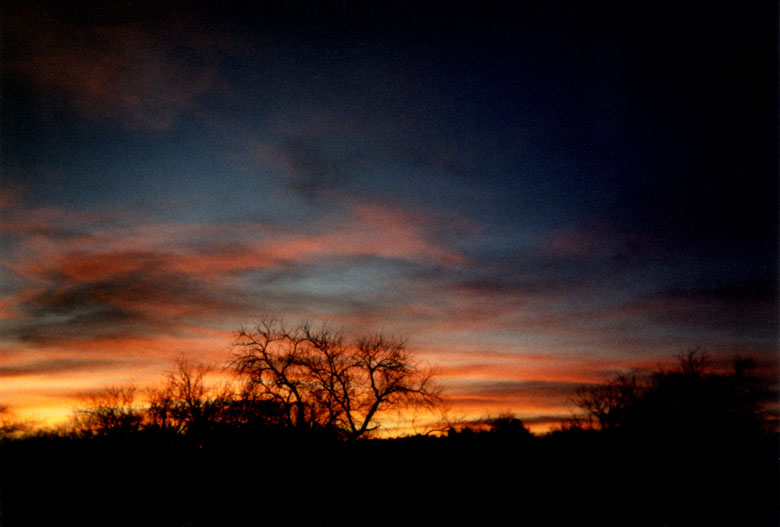
A “Hunter's Sunset” — with a clearing red sunset, with or without high wispy clouds — is always a good portend for the next day's hunting. The weather should be nice — with low velocity winds.
“Light and variable winds with a high of forty,” the local weatherman announced. “What?” I blurted out loud, dropping my book to my cot and swinging my feet to the tent floor. “A thaw … we're going to have a thaw after two days of near-zero temperatures … and the wind will be light. Oh boy.”
Now I was excited. “You won't be able to stand it, ol' buck,” I thought, my finger on my scouting map. “Tomorrow, sometime between 11 AM and 3 PM while the trees are dripping, you're going to take to your old scrape trails. And when you do, I'll be waitin at Grandpa's stand. You'll move north on one of those two trails.”
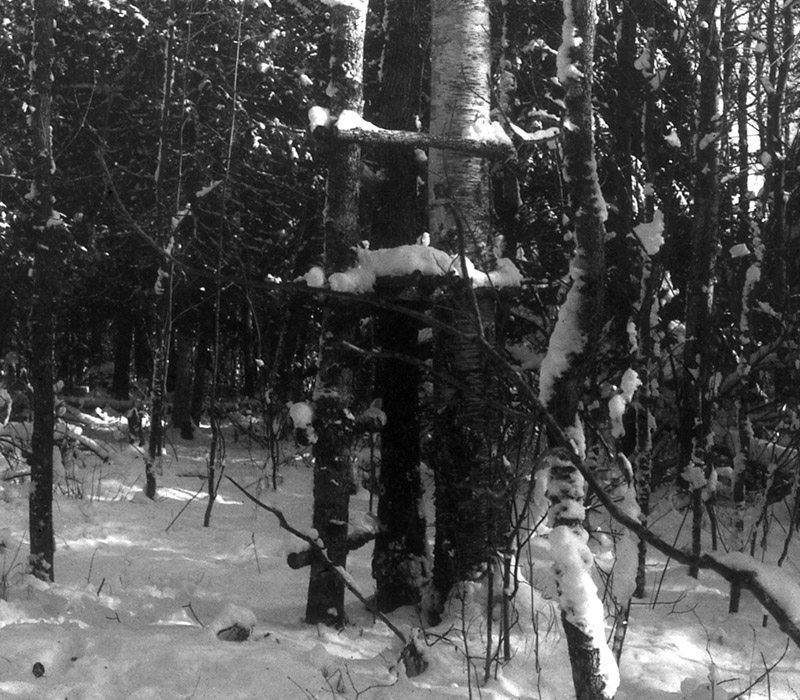
[Editorial Note: This may be the exact treestand Doc refers to in the story.]
It was noon when the range doe suddenly jerked her head up and gazed suspiciously toward the cedar on my left. Then a cascade of snow slipped from the drooping bough of another evergreen behind her, immediately drawing her attention in that direction. The forest was alive with dripping branches and “whumps” of falling clumps of snow. The doe was nervous, but determined to feed. Shortly, she flicked her tail and drifted slowly east along the trail 30 yards south of my stand, her fawn, ears pinned back, close on her heals.
Almost three hours later, I was beginning to feel doubts. Was the buck's fear of me now greater than its urge to check the current state of does (any in heat?) in its breeding range?
After seeing the doe pass earlier, I sat watching the south trail, figuring this would be the path most likely to be taken by the 10-pointer. The other trail coursed through alders and windfallen evergreens 20 yards behind me. “If he takes to that trail,” I had reasoned, “I'll surely hear him coming.” Nonetheless, I occasionally turned my head to the right, keeping an eye on this trail where it passed through a patch of low hazels 75 yards west.
I didn't expect to see anything when I turned my head for what seemed like the hundredth time. In fact, I had about given up. The dripping had almost stopped. But there it was. The 10-pointer, high and wide, ivory-tipped antlers glinting in the sun, pushed toward me through the hazels, head high, moving jauntily, almost as if only out for a brisk walk in the park. The trouble was, I couldn't move. I was in the buck's direct line of sight. I'd have to wait until it passed.
Heart pounding, knees trembling, I willed myself to concentrate, thinking only of the actions I must take before I would be able to take aim. I'd have to make an oozing, 180-degree turn, ease my safety forward without sound (using both thumbs) and raise my rifle to my shoulder, all within 20–30 yards of one of the most sensitive and cunning bucks I had ever known.
I did it.
I sat for some time before the downed buck in the quiet of the dripping alders and windfalls that evening so many years ago, in awe of the fact that all my pre-season scouting, planning and stand site preparations, so exhausting months earlier, had worked so well. This 10-pointer was the best of his breed, but I had somehow stayed right with him day after day, reasons for selecting the stands I used always in the ball park. With that came the realization I could ever after hunt bucks such as this, experiencing the very best of whitetail hunting.
That, my friend, is what greater mobility in standing hunting will also do for you.
Good Luck Hunting,
Doc


